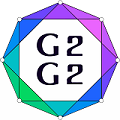Speaker
Description
There is an infinite sequence of formally self-dual classical distance-regular graphs $\Gamma$ with classical parameters $b=2$, $\alpha=1$, $\beta=n-1$, $v=n^3$ $(n>5)$.
If $n$ is a power of $2$, then there exists a distance-regular graph $\Gamma$ with intersection array $\{7(n-1),6(n-2),4(n-4);1,6,28\}$ and each distance-regular graph with these parameters is a bilinear forms graph. Moreover, all these graphs are locally grid.
We consider graphs $\Gamma$ with intersection array $\{7(n-1),6(n-2),4(n-4);1,6,28\}$, where $n$ is not a power of 2. By the results of Metsch, if $n\ge 71$, then graphs with intersection array $\{7(n-1),6(n-2),4(n-4);1,6,28\}$ don't exist.
If $n=6$, then the intersection array of $\Gamma$ is $\{35,24,8;1,6,28\}$. The nonexistence of a graph with this intersection array was proved by A. Jurishich and J. Vidali. The case when $n=7$ was ruled out by I.N. Belousov and A.A. Makhnev. The proof was based on counting of some triple intersection numbers.
In this work, we consider the case $n=9$. In this case, there are $6$ admissible spectra for the integral local subgraph. One of them is relate to the $7\times 8$-grid.
We prove that a distance-regular graph with intersection array $\{56,42,20;1,6,28\}$ does not exist, if some its local subgraph is the $7\times 8$-grid.
Acknowledgments. The work is supported by Russian Science Foundation (project 19-71-10067).

